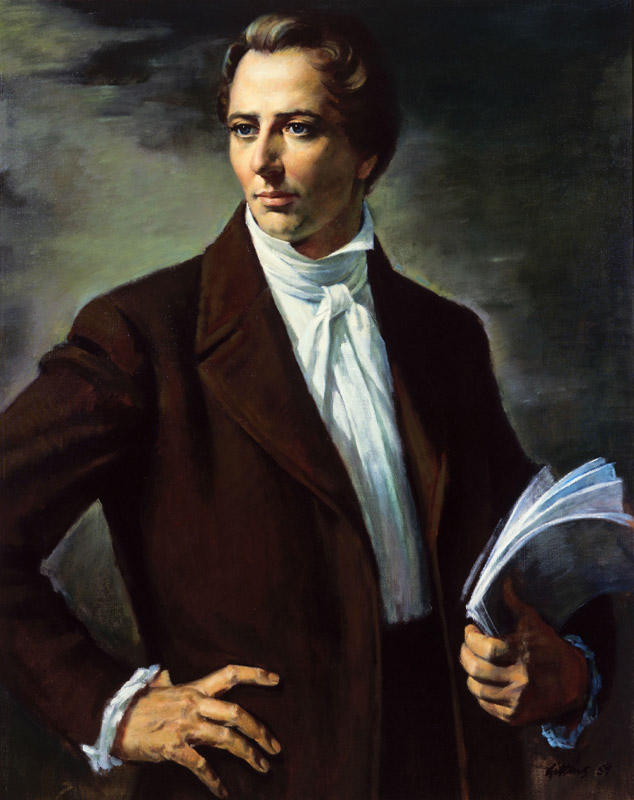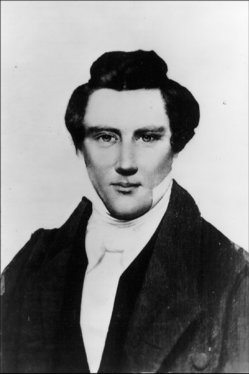Difference between revisions of "Joseph Smith, Jr."
| Line 39: | Line 39: | ||
:''For more information see, [[Martyrdom of Joseph Smith]]'' | :''For more information see, [[Martyrdom of Joseph Smith]]'' | ||
| + | |||
| + | '''To see a video of late President Gordon B. Hinckley at the Sacred Grove testifying of the restoration of the gospel, click [http://jesuschrist.lds.org/SonOfGod/eng/special-witnesses/video/president-gordon-b-hinckley-1910-2008-sacred-grove here.]''' | ||
==External Links== | ==External Links== | ||
Revision as of 13:06, 5 March 2008
Joseph Smith, Jr. (1805-1844) was the founding prophet of The Church of Jesus Christ of Latter-day Saints. Mormons call him a prophet because, according to the traditional role of prophets recorded in the Old and New Testaments, he relied on revelation from God for teaching the people, and not on his own wisdom or learning.
The Prophet Joseph Smith is one of the most charismatic and influential religious figures in American history. Joseph Smith acquired many followers throughout his life, but also many opponents, because his teachings were not welcomed by most people in the existing Christian community. For many of them, the doctrines he taught were nothing more than blasphemy and contrary to their interpretation of the Bible. At the beginning, the main sticking point was Joseph's Smith's claim to revelation, which most Christians believed had ceased upon the death of Christ's apostles.
History of Joseph Smith
Joseph Smith's ancestors were ordinary New England farm people who emigrated from England to America in the seventeenth century and settled in Massachusetts. Joseph Smith was born on December 23, 1805, in Sharon, Vermont, the son of Joseph and Lucy Mack Smith. In his youth Joseph was largely deprived of a formal education, but he was instructed in reading, writing, and the basic rules of arithmetic; his mother reported that he was often given to meditation and deep study.
The Smiths moved several times in less than twenty years. When Joseph was eleven, his family moved to Palmyra, New York, where Joseph lived almost all of his later childhood. This area was known as the "burned-over district," because it was given to frequent and fervent religious excitement. Various Christian sects sponsored tent meetings and revivals, and they competed vigorously for converts.
In 1820, at the age of fourteen, Joseph was deeply perplexed about which church he should join, and the conflicting preaching of many religious ministers increased his uncertainty. Members of his immediate family were drawn to the Methodist and Presbyterian Churches. Joseph was determined to know which of the many religions was right. After reading a passage in the Bible in the Book of James, instructing any who lacked wisdom to "ask of God" (James 1:5), Joseph decided to turn directly to God for guidance.
Early one morning in the spring of 1820, Joseph went to a secluded wood to ask God which church he should follow. As he was praying, as he recounted later, God the Father and His Son, Jesus Christ, appeared to him. This experience is called the First Vision in Mormonism and considered a pivotal event in the history of humankind, second only to the death and resurrection of Jesus Christ. The importance of the event hinges on its definition as the beginning of the restoration of Christ's true gospel on earth, which was lost upon the death of the original apostles.
Later, in 1823, Joseph Smith said he was also visited by an angel named Moroni, who told him of an ancient record containing God's dealings with the former inhabitants of the American continent. Joseph was shown the forest location of the record's hiding place by the angel. However, he was also told that he should wait another four years before being able to obtain the record, and that until then he should return each year to the same place to receive further instructions. In 1827, Joseph was finally able to retrieve the record, which was inscribed on golden plates. Shortly after obtaining these golden plates, Joseph Smith began translating its words by the "gift of God."
The result of his translating efforts became known as the Book of Mormon—Another Testament of Jesus Christ, which was published in March of 1830. Following the publication of the Book of Mormon, on April 6, 1830, the prophet finally organized the Church and became its first president.
While working in Harmony, Pennsylvania, in 1825, Joseph Smith met Emma Hale. On January 18, 1827, Joseph and Emma were married. Together they had eleven children (including two who were adopted), only five of whom lived past infancy. Joseph deeply loved his family, and his personal writings are filled with concerns and prayers for the welfare of his family.
The Martyrdom
On June 27, 1844, while in Carthage Jail, Joseph Smith and his brother, Hyrum Smith, were killed by a mob consisting of men with blackened faces. (See Carthage Jail). After the Prophet's death, John Taylor, an eyewitness to the martyrdom, wrote the following:
Joseph Smith, the Prophet and Seer of the Lord, has done more, save Jesus only, for the salvation of men in this world, than any other man that ever lived in it
During his short life, the Prophet Joseph established cities, produced volumes of scriptures, and sent missionaries throughout the world. He was involved in the construction of temples, served as mayor of Nauvoo, and was even a candidate for the presidency of the United States.
He has been described by men not of his faith as the most influential religious leader in American history. He was definitely a controversial figure who attracted persecution because he challenged established creeds.
Members of the Church of Jesus Christ of Latter-day Saints do not worship the Prophet Joseph, but they do revere him as the instrument by which the Gospel of Jesus Christ was restored to the earth.
Joseph Smith was succeeded as President of the Church by Brigham Young.
- For more information see, Martyrdom of Joseph Smith
To see a video of late President Gordon B. Hinckley at the Sacred Grove testifying of the restoration of the gospel, click here.
External Links
- Facts about Joseph Smith Jr. -- LDS.org
- Joseph Smith - Home
- Joseph Smith - American Prophet
- Joseph Smith Daguerreotype
- JS-H 1
- Fufilled Prophecies of Joseph Smith
- Joseph Smith - Lightplanet
- Joseph Smith: Biography and Much More From Answers.com
- Joseph Smith Jr. - Wikiquote
- The Testimony of the Prophet Joseph Smith
- Joseph Smith - bellsouth
- Joseph Smith: Prophet, Revelator, Human; Interview with Richard Lyman
- Joseph Told the Truth: Responses to accusations about Joseph Smith
- Video lecture:Accusations against Joseph Smith addressed
- Joseph Smith's First Vision Accounts

